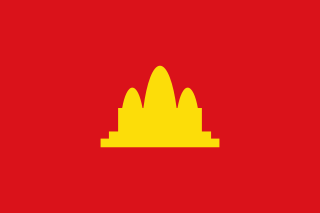
The Khmer Rouge is the name that was popularly given to members of the Communist Party of Kampuchea (CPK) and by extension to the regime through which the CPK ruled Cambodia between 1975 and 1979. The name was coined in the 1960s by then Prime Minister Norodom Sihanouk to describe his country's heterogeneous, communist-led dissidents, with whom he allied after his 1970 overthrow.

Sinn Sisamouth was a Cambodian singer-songwriter active from the 1950s to the 1970s.
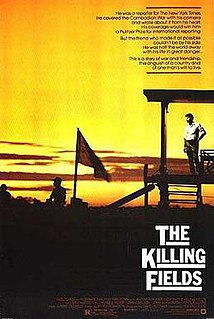
The Killing Fields is a 1984 British biographical drama film about the Khmer Rouge regime in Cambodia, which is based on the experiences of two journalists: Cambodian Dith Pran and American Sydney Schanberg. It was directed by Roland Joffé and produced by David Puttnam for his company Goldcrest Films. Sam Waterston stars as Schanberg, Haing S. Ngor as Pran, Julian Sands as Jon Swain, and John Malkovich as Al Rockoff. The adaptation for the screen was written by Bruce Robinson; the musical score was written by Mike Oldfield and orchestrated by David Bedford.
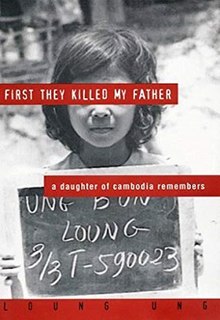
First They Killed My Father: A Daughter of Cambodia Remembers is a 2000 non-fiction book written by Loung Ung, a Cambodian-American author and childhood survivor of Democratic Kampuchea. It is her personal account of her experiences during the Khmer Rouge regime.

Cinema in Cambodia began in the 1950s, and many films were being screened in theaters throughout the country by the 1960s, which are regarded as the "golden age". After a near-disappearance during the Khmer Rouge regime, competition from video and television has meant that the Cambodian film industry is a small one.

Media in Cambodia is vibrant and largely unregulated. This situation has led to the establishment of numerous radio, television and print media outlets. Many private sector companies have moved into the media sector, which represents a significant change from many years of state-run broadcasting and publishing.
Tep Rindaro is a Cambodian actor and singer. He started acting in 1987. With his career spanning more over 30 years, he is one of the longest starring actors in Cambodia since the fall of the Khmer Rouge in 1979.
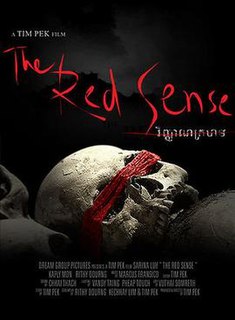
The Red Sense is a 2006 Khmer-Australian supernatural thriller film. It was director Tim Pek's debut film and was produced by Transparent Pictures. The success of The Red Sense led Transparent Pictures to produce films such as Bokator and Annoyed. The Red Sense was first released in Australia in August 2008, and though banned for general release there, screened in Cambodia in December that year. It is rated M by the Office of Film and Literature Classification of Australia.
Horror films in Cambodia, first popular in the 1970s, have received renewed attention in Cambodian film making since the resurgence of the local industry in 2003. Horror is one of three popular genres into which most Cambodian films can be loosely grouped, the other two being period pieces and melodrama/romantic drama. The fledgling Cambodian industry of the mid 2000s looked to capitalize on the world-wide popularity of Japanese horror films which have heavily influenced Cambodian horror films. Common themes are ghost or spirit hauntings, possession, folk mythology and revenge by supernatural means. The storytelling takes a slower pace than Western horror and relies on suspense, a pervasive sense of doom and dread, and psychologically disturbing events and situations. Unlike its Japanese counterparts however, many Cambodian horror films also feature over the top gore as seen in Western horror.
This is an incomplete, chronological list of films produced in the Khmer language in the 2000s.
Camerado is a commercial film, video and multimedia production group that produces independent, multicultural-themed films, videos, and media events with a prosocial agenda.
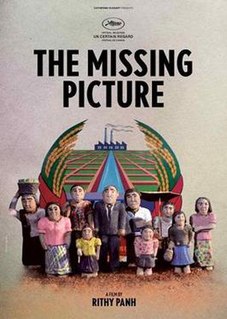
The Missing Picture is a 2013 Cambodian-French documentary film directed by Rithy Panh about the Khmer Rouge. It was screened in the Un Certain Regard section at the 2013 Cannes Film Festival where it won the top prize. It was also screened in the World Cinema section at the 2013 Cinemanila International Film Festival where it won the Grand Jury Prize. It won the Lumières Award for Best Documentary at the 21st Lumières Awards and was nominated for the César Award for Best Documentary Film at the 41st César Awards.
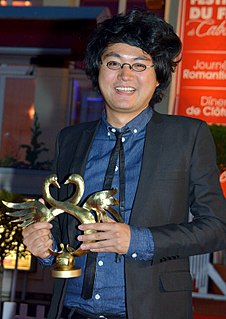
Davy Chou is a Cambodian-French filmmaker. He is the grandson of Van Chann, who mysteriously disappeared in 1969. Davy Chou only discovered in his teens that his grandfather had been one of Cambodia's leading film producers in the 1960s.

The Cambodian genocide was the systematic persecution and killing of Cambodians by the Khmer Rouge under the leadership of Communist Party of Kampuchea general secretary Pol Pot, who radically pushed Cambodia towards an entirely self-sufficient agrarian socialist society. It resulted in the deaths of 1.5 to 2 million people from 1975 to 1979, nearly a quarter of Cambodia's 1975 population.

First They Killed My Father is a 2017 Cambodian–American Khmer-language biographical historical thriller film directed by Angelina Jolie and written by Jolie and Loung Ung, based on Ung's memoir of the same name. Set in 1975, the film depicts 7-year-old Loung, who is forced to be trained as a child soldier while her siblings are sent to labor camps during the Khmer Rouge regime.
Khmer sastra is a sastra, or manuscript, written during and after the Khmer Empire, from at least the 12th century, in Southeast Asia.
This page is based on this
Wikipedia article Text is available under the
CC BY-SA 4.0 license; additional terms may apply.
Images, videos and audio are available under their respective licenses.










